BILL MITCHELL TAKES A HAND
Like his mentor, Harley Earl, GM styling director Mitchell loved sports cars. When Earl had Chevy engineers build a Corvette-based racer, the SR-2, for his son, Jerry, Mitchell ordered a second built for his own use. During his tenure as head of GM design from 1958 to 1977, he would commission a whole series of custom-built, high-powered sports cars for his own use.
Many of Mitchell’s staff were of a similar bent. In 1956, stylists Robert Cumberford and Tony Lapine (who would later design the Porsche 928) were playing with ideas for an advanced Corvette for 1958, featuring an aluminum body, a rear transaxle, and a retractable hardtop. It was rejected on cost grounds, but it made clear that GM designers were clearly as eager as Duntov to take the Corvette in a more sophisticated direction.
Naturally, the prospect of the Q-Corvette was very exciting. Mitchell made it more so when he returned to Detroit from the Turin Auto Show. He called for an informal design contest to develop the styling cues for the Q-Corvette. The winner was a young designer named Pete Brock, whose sketches Mitchell chose in October 1957. Mitchell told him it was the right direction, and instructed him to proceed. Stylist Bob McLean subsequently fashioned it into a sleek, low-slung coupe, which was built as a full-size clay model.
Fishing for New Inspiration
Automotive designer Bill Mitchell was hired by General Motors in the 1930s and quickly rose through the ranks at GM. He was soon tapped as the Chief Designer over in the Cadillac division and eventually became GM’s Director of Styling, right underneath the legendary Harley Earl. And when Earl retired in 1958, Mitchell took charge of all of General Motors’ automotive styling efforts.
In a general sense, Mitchell wanted to break away from the extravagance of the 1950s and its chromed, tail-finned excess. To that end, he encouraged his designers to draw inspiration from the tasteful restraint of famous European marques.
 A 1957 Corvette SS race car (pictured) donated its chassis to the Stingray Racer developed by Bill Mitchell. (Image/OnAllCylinders)
A 1957 Corvette SS race car (pictured) donated its chassis to the Stingray Racer developed by Bill Mitchell. (Image/OnAllCylinders)
But it was a fateful deep-sea fishing trip that provided the influence for the C2 Corvette.
During the trip, Mitchell caught a shark and was taken by its long, sleek silhouette. He worked closely with a design team that included automotive legends Peter Brock and Larry Shinoda to develop a workable concept.
And what followed was the experimental XP-87 Stingray Racer in 1959.
 Bill Mitchell poses with his 1959 Stingray Racer. (Image/GM – Chevrolet)
Bill Mitchell poses with his 1959 Stingray Racer. (Image/GM – Chevrolet)
The Stingray Racer was built on a retired Corvette SS chassis, and featured a small block Chevy V8 topped with aluminum heads, Rochester fuel injection, and a tidy 11:1 compression ratio.
And it was fast too. Campaigned by “The Flying Dentist” Dr. Dick Thompson in 1960, the Stingray Racer won an SCCA National Championship.
Yet while the Stingray Racer only gave hints to where C2 styling was headed, it heavily influenced the XP-720 project that would become the nascent second-gen Corvette.
Discover the fascinating history of the iconic C2 1967 Corvette Sting Ray, from its specs and options to its colors and unique features. Explore restored and original models with photos and pricing information.
1967 Corvette Specifications, Options, Costs, Colors, Facts, and Details
The 1967 Corvette Sting Ray sports car has some of the best-known options, specifications, costs, colors, facts, and details of any vehicle in history and deserves to be among the top 10 most famous vehicles in automotive history as well as one of the top collector vehicles in the world today.
Various reasons were behind General Motors’ decision to extend the production of the current model for one more year. One theory was that the release of the C3 had been intentionally delayed to work on the Chevrolet Camaro in 1967. In spite of what critics and enthusiasts predicted, the C2 1967 Corvette Sting Ray wasn’t actually the first of a new generation, but it was the most refined of the second-generation Corvettes.
Throughout this article, we will be discussing the 1967 Corvette Specifications and its pricing, colors, facts, and other details, with accompanying photos of some of the best restored and original Corvettes.

1966 Corvette
Big block engines dominated the Corvette Stingray story for 1966. They first appeared in April 1965 and as such had limited exposure. 1966 extended the big block Corvette story with the introduction of the legendary 427 cu. in. motors. They were bored and stroked versions of the 396 cu. in. 1965 big block motors and were available in two flavors: 390 hp (RPO L36, $181.20) and 425 hp (RPO L72, $312.85). The extra cost for the L72 was justified as it included four bolt mains, impact extruded aluminum pistons, a very aggressive camshaft, Holly 780 CFM carburetor mated to a aluminum intake and a free-flowing exhaust. The K66 transistorized ignition was a mandatory option with the L72. There are reports that the L72 actually featured more horsepower than the 450 hp that was quoted. The specifications were downgraded to avoid undesirable backlash from safety legislation, but enthusiasts only had to read the magazine reviews to learn what was really going on.
THE CHEVROLET CORVETTE
Although it was undeniably pretty, the original Corvette, introduced in 1953, was in many ways a glorified show car. It had been designed in great haste, using a lot of off-the-shelf pieces, and it was neither very practical nor particularly sporting. Despite its fiberglass body, it was heavy for a sports car and its performance was compromised by a poorly sorted suspension and compulsory automatic transmission. It had no exterior door handles or locks, clumsy side curtains instead of windows, hard-to-read instruments, and mediocre fit and finish. It was little wonder that in 1954, the Corvette’s first full year of production, Chevrolet managed to find homes for only 2,780 of the 3,640 cars built.
The original Chevrolet Corvette was powered by a souped-up version of Chevrolet’s trusty “Blue Flame” six, making 150 (later 155) gross horsepower (112 and 116 kW). Mated only to a two-speed Powerglide automatic, it offered brisk but not sizzling performance: 0-60mph (0-97 km/h) in about 11 seconds, a top speed of a bit under 110 mph (177 km/h). Note the absence of door handles — the 1953-55 Corvettes had neither door handles nor roll-up windows. (Photo: “NCRS Winter Meet 2009 (1954 Chevrolet Corvette)” 2009 Allen/Latvian98; used with permission)
Despite that mediocre showing, which nearly sent the roadster to an early grave, the Corvette had already acquired a small but loyal following within GM. Its fans included formidable Styling boss Harley Earl (who had originally conceived it); Earl’s lieutenant, Bill Mitchell; and a fiery Russian-born engineer named Zora Arkus-Duntov.
It was Duntov who had saved the Corvette from cancellation with an impassioned memorandum to Chevrolet chief engineer Ed Cole and Research and Development chief Maurice Olley. Duntov’s memo, written in December 1953, argued forcefully that canceling the Corvette would hurt Chevrolet’s reputation, particularly with young, performance-minded customers. He proposed instead that Chevy build a real performance image for the Corvette, which would earn the loyalty of enthusiasts and add luster to the rest of the line.
In 1955, the Corvette got Chevrolet’s new 265 cu. in. (4,344 cc) V8 engine and a manual transmission. The following year, it was revamped with proper door handles and locks, roll-up windows and even-more-powerful engines, with up to 240 horsepower (179 kW). After three years of Chevrolet insisting it was not a sports car, the Corvette made its first forays into real competition, earning the grudging respect of sports car purists.
Bill Mitchell developed this show car (code-named XP-755 and later named “Shark” after Mitchell caught a shark during a fishing trip) in early 1961, foreshadowing the styling of the 1963 Corvette. Mitchell used the Shark as his personal car for a time; Chevrolet general manager Semon “Bunkie” Knudsen also ordered a copy for his own use. In 1965, it was renamed “Mako Shark I” when Chevrolet unveiled the Mako Shark II show car, which foreshadowed the 1968 Chevrolet Corvette C3. (Photo: “1961 Corvette Mako Shark” 2008 Jim Greenfield (Jim G Photography); used with permission)
Duntov did his best with the Corvette’s humble underpinnings, but its chassis and brakes, derived from rustic passenger-car hardware, were not well suited to sports-car duty. A competition handling package helped, but Duntov still had dreams of better weight distribution, an independent suspension, and disc brakes — in short, exactly what a “Q-Corvette” would offer.
Q-SHIPS
General Motors in the 1950s and early 1960s routinely dazzled America with its spectacular traveling auto shows and futuristic concept cars. Its well-funded research department explored everything from front-wheel drive to gas turbine engines. Visiting the Motorama, one could almost imagine that flying cars wearing Chevy badges were only a few years away.
Chevrolet’s production engineering seemed to be on the move, as well. Under the leadership of chief engineer (and later general manager) Ed Cole, the division got a modern, overhead-valve V8 engine in 1955, and well-heeled buyers could add the latest luxury features, including power steering, power windows, and air conditioning. By 1957, the options list had grown to include fuel injection and the sophisticated (if unreliable) triple-turbine Turboglide automatic transmission.
Although Chevrolet’s chassis engineering — body-on-frame construction and Hotchkiss drive — could have come from a prewar car, even that seemed about to change. In 1957, the corporate Engineering Staff began work on a radical new program known as project “Q,” originally slated for the 1960 model year. Project Q promised a rear-mounted transaxle (for better weight distribution), independent rear suspension, and (according to some accounts) four-wheel disc brakes, which would have made GM’s the most sophisticated sedans in the world. It would also provide the perfect opportunity to make a cutting-edge sports car out of the Corvette.
A Brief History Of The Second Generation Chevrolet Corvette
Via Flickr
The 1963 Corvette Stingray kicked off the second generation (C2) of the Corvette sports car models manufactured by the Chevrolet division of General Motors. The C2 would be produced through to the 1967 model year. The development of this car has roots in two separate GM projects, namely, the Q-Corvette and the Bill Mitchell racing Sting Ray.
Renowned American automobile designer Bill Mitchell was blown away by the strong horizontal styling of cars like the Abarth 750 Streamliner and Alfa Romeo Disco Volante paraded at the 1957 Turin Auto Show. The Q-Corvette project on the other hand referred to the Chevy GM Ed Cole’s initiative to build cars whose defining features are a front-mounted engine and a rear-mounted transaxle. Mitchell showed pictures of the cars he’d seen at the Turin Auto Show to the Q-Project design team.
However, the project would later be scrapped, following the exit of GM Chairman Harlow Curtice. Still, the idea of a smaller, but more advanced coupe-only Corvette did not die with the Q-Project. By that time, GM’s engineers were already enthralled by the mid and rear-engine designs and the Q-Corvette’s proposed 4-wheel disc brakes and inboard-mounted rear brakes. The cars they envisioned would have a long snout, peaked fenders, and a short tail.
Via Flickr
Famed engineer Zora Arkus-Duntov was already experimenting with this mid/rear-engine design approach on the 1959 lightweight, open-wheel, single-seat CERV I concept. GM equally considered building a rear-engine Corvette. In fact, the marquee had come as close as developing a full-scale mock-up designed around the Corvair’s entire rear-mounted power package, including its air-cooled flat-six, as an alternative to the Corvette’s usual water-cooled V8.
Finally, in 1959, elements of the novel Q-Corvette project, and Bill Mitchell’s Sting Ray racer, would be integrated into the company’s experimental design program XP-720. The focus was on improved passenger comfort and luggage space as well as improved driving and handling performance. In short, the XP-720 project was earmarked to deliver superior performance over previous Corvettes. This program represents the final lap in the 1963 Corvette Stingray’s developmental journey.
While Duntov, the man fondly regarded as the father of the Corvette, worked on the innovative new chassis, GM’s design team focused on adapting and fine-tuning the basic look of the racing Sting Ray for the production model. Improved aerodynamics was a major focal point in the development of the second-gen Corvette Stingray. It was the very first time in the history of the Corvette nameplate that wind tunnel testing would determine the final design of not just the exterior, but also the interior, windshield curvatures, and tooling limitations.
1963-67 C2 Corvette: A Rousing Success!
 Above: The all-new 1963 Corvette’s chassis had a shorter wheelbase, with improved weight distribution. Zora Arkus-Duntov’s team of engineers moved the engine back in the chassis and added 80 pounds to the rear suspension, which made for a better front to rear weight balance — practically 50/50 weight distribution. With the incorporation of a single transverse leaf spring and shock absorbers for the rear, the chassis also had four-wheel independent suspension for the first time ever. In addition, the two passengers actually now sat inside the frame rails, which lowered the center of gravity for the Corvette Sting Ray. A brilliant and bewitching form followed a seriously enhanced and innovative function, which transformed the C2 Corvette into a world class sports car!
Above: The all-new 1963 Corvette’s chassis had a shorter wheelbase, with improved weight distribution. Zora Arkus-Duntov’s team of engineers moved the engine back in the chassis and added 80 pounds to the rear suspension, which made for a better front to rear weight balance — practically 50/50 weight distribution. With the incorporation of a single transverse leaf spring and shock absorbers for the rear, the chassis also had four-wheel independent suspension for the first time ever. In addition, the two passengers actually now sat inside the frame rails, which lowered the center of gravity for the Corvette Sting Ray. A brilliant and bewitching form followed a seriously enhanced and innovative function, which transformed the C2 Corvette into a world class sports car!
 Above: VP of Design Bill Mitchell had a heated argument about the two-pane glass split-window rear windscreen of the 1963 Corvette coupe with Head of Corvette Engineering Zora Arkus-Duntov. Mitchell said that the spine of the coupe was a crucial design element of the C2. Duntov countered that the spine ruined rearward visibility and increased production costs. In the end, the two compromised. Mitchell relented and said that the split-window would only be a one-year feature. Initially, some new coupe owners in 1963 had the spine removed and an aftermarket plexiglass rear windshield installed. Due to its rarity and aesthetic appeal, as most Corvette enthusiasts are aware, this one-year design element plays a huge part in what makes the 1963 Corvette coupe so valuable and collectible today. Sometimes function follows form — with the advantage of hindsight.
Above: VP of Design Bill Mitchell had a heated argument about the two-pane glass split-window rear windscreen of the 1963 Corvette coupe with Head of Corvette Engineering Zora Arkus-Duntov. Mitchell said that the spine of the coupe was a crucial design element of the C2. Duntov countered that the spine ruined rearward visibility and increased production costs. In the end, the two compromised. Mitchell relented and said that the split-window would only be a one-year feature. Initially, some new coupe owners in 1963 had the spine removed and an aftermarket plexiglass rear windshield installed. Due to its rarity and aesthetic appeal, as most Corvette enthusiasts are aware, this one-year design element plays a huge part in what makes the 1963 Corvette coupe so valuable and collectible today. Sometimes function follows form — with the advantage of hindsight.
When the 1963 Corvette first ever coupe and convertible premiered in October of 1963, they were an instantaneous hit with the public and with the automotive press. The car was praised for its power, handling poise over all road surfaces, and its beautiful shape. The C2 Corvettes sold well throughout their short five-year run, much better than the first-generation Corvettes fared. In doing so, America’s Sports Car could continue for years to come, thanks to the tireless efforts of many great dedicated designers and engineers, some of whom are mentioned here.
Our First Example of a Stock 1967 Corvette
Our first example of a beautiful matching number 67 Corvette is owned by David and Mary Matlock. The Matlocks received the Vette Vues Magazine’s Tri-Power Award at the Galveston Corvette Chevy Expo. The 38th Corvette/Chevy Expo was held at the beautiful Galveston Island Convention Center, right on the Gulf of Mexico, February 27 & 28, 2016.
67 Corvette owned by David and Mary Matlock
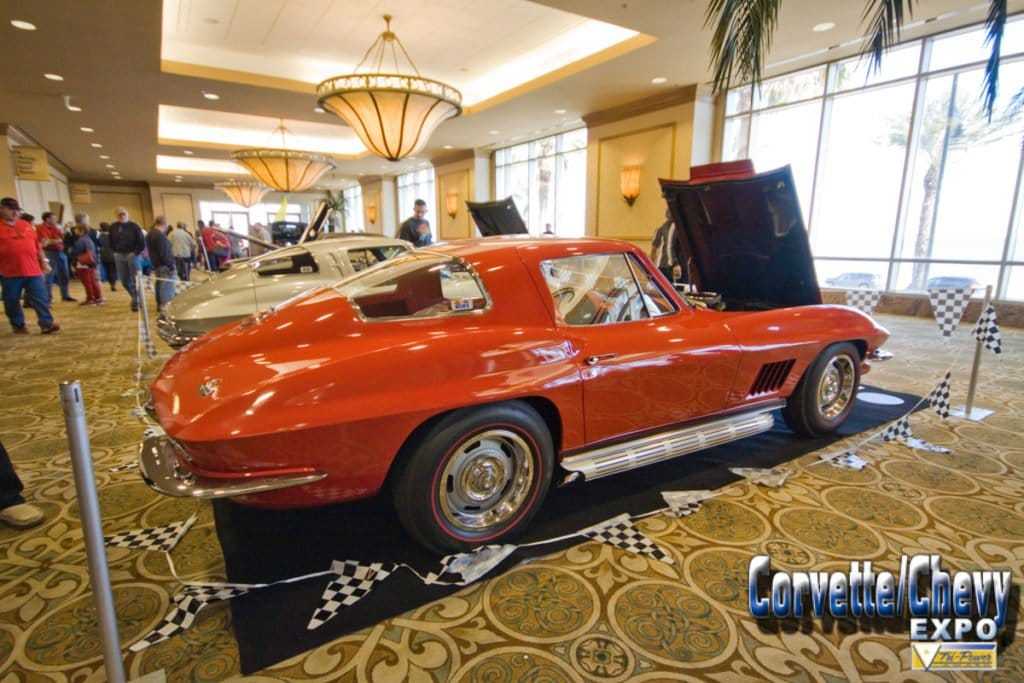 As we look at the 1967 Corvette Sting Ray Specifications on this car, a few stand out. The Rally Red paint, aluminum bolt-on wheels, side dual exhaust, and redline tires.
As we look at the 1967 Corvette Sting Ray Specifications on this car, a few stand out. The Rally Red paint, aluminum bolt-on wheels, side dual exhaust, and redline tires.
 1967 Rally Red Corvette. The 1967 Corvette air vents had five smaller vents in place of the three larger vents featured on the earlier C2 Corvettes.
1967 Rally Red Corvette. The 1967 Corvette air vents had five smaller vents in place of the three larger vents featured on the earlier C2 Corvettes.
LAST HURRAH
The Corvette Sting Ray was originally slated for replacement in 1967, but delays with its successor earned it an unscheduled encore. The 1967 Corvette still sold well and many buyers found its styling — now free of some of the minor gimmicks that cluttered the early models — the most tasteful of the lot.
Sales of the 1963-1967 Corvette Sting Ray never quite reached 30,000 a year, but by the time production ended in July 1967, combined C2 Corvette production had reached 117,964. That was far better than Chevrolet had expected and a vast improvement over the mediocre numbers of the mid-1950s. The Corvette Sting Ray also earned Chevrolet a great deal of favorable publicity both in the U.S. and abroad. It had its limitations, to be sure, but so did its principal rivals, most of which were a lot more expensive.
Although the Corvette Sting Ray coupe got the most attention, buyers of 1963-1967 Corvettes preferred the convertible. Sales of the two models were nearly even for 1963, but the convertible subsequently outsold the coupe by a large margin. Part of the reason was price: the coupe was more than $200 more expensive.
Duntov, Mitchell, and Larry Shinoda spent much of the Corvette Sting Ray’s lifespan immersed in the contentious development of its successor, which finally bowed for 1968. Duntov still had grand ambitions for a smaller, lighter, mid-engine Corvette, but it was not to be. The C3 Corvette ended up as a mechanical carryover of the C2, with a new body that took the Sting Ray’s styling themes to the edge of Camp. It proved to be a long-lived design, lasting until 1982. Its successors, the 1984 C4, the 1997 C5, and the 2005 C6, had more advanced technology (ultimately including a transaxle like that originally planned for the Q-Corvette), but hewed closely to the 1963-1967 Corvette Sting Ray’s look and concept.
The sad thing was not that the Sting Ray’s successors followed in its footsteps, but that no other GM cars did. Its disc brakes and three-link suspension, though not cutting edge by today’s standards, could have done wonders for GM’s ordinary sedans, reviving some of the concepts from the old Q-sedan project to good effect. Naturally, that never happened, largely on cost grounds. The irony was that for all GM’s concern about cost effectiveness, Chevrolet’s engineering department was significantly over budget throughout the sixties. For all the money GM spent, the technology of its cars seemed to be standing still.
The only reason the Corvette Sting Ray ended up as sophisticated as it did was the stubborn determination of its designers, and their willingness to bend or break the corporation’s rules to get what they wanted. Remarkably, Duntov and Mitchell’s successors have largely kept that faith, carving out a surprising level of independence for the Corvette within the Chevrolet organization. Whatever you feel about the Corvette — and we must admit it’s not exactly our cup of tea — you must admire the fact that its designers and engineers have never lost sight of what it’s supposed to be, even in the face of daunting opposition from both inside and outside the company.
A few months ago, Robert Farago, editor of The Truth About Cars, published an editorial suggesting that GM kill the Corvette as a sign of its renewed commitment to building good bread-and-butter cars, rather than a few expensive halo models like the ‘Vette or the Cadillac CTS-V. We understand his reasoning, but we would rather see the kind of passion and commitment evident in the Corvette extended to GM’s other products. If they could do that, then General Motors might actually stand a chance.
FIN
C2 Corvette Identification Guide & Year Differences
Need help determining which year 1963-67 C2 Corvette you’re looking at? Check out the photos and captions below for some key features and design elements that changed over the years.
1963 C2 Corvette: The Start of a Generation

Above and below: This Riverside Red with red vinyl 1963 convertible is the earliest-known second-generation Corvette that was sold to the general public. It’s equipped with the 360-horsepower Rochester mechanical fuel-injected 327-cubic inch V8 engine (L84) and backed by a Muncie four-speed manual transmission.

1964 C2 Corvette: No More Split Window
After only one year of production, the distinctive split rear window was switched to a more conventional single rear window. Additionally, indentations were present on the hood where louvers would have been, but no chrome louvers were present. This created a sleeker appearance.

Above and below: Notice that the split window is gone with the 1964 Corvette coupe. This particular coupe has a 327/300 c.i./horsepower V8 engine, power steering, power brakes, power windows, positraction rear end, factory air conditioning, rare Saddle Tan paint with saddle leather interior, knock-off aluminum wheels, tinted glass, backup lights, and a Muncie four-speed manual transmission. Basically, this coupe came loaded from the Chevrolet Corvette factory. The Vette was sold new by Holler Chevrolet in Winter Park, Florida to Hughes Supply Inc. Notice that the 1964 Corvettes have the indentations in the hood for the faux chrome cooling louvers, but they don’t have the louvers. The Tuxedo Black beauty below sports a 375-horsepower Rochester mechanical fuel-injection topped 327 ci V8 and a Muncie four-speed manual trans. It’s one of 1,325 fuel injected Corvettes built in 1964.
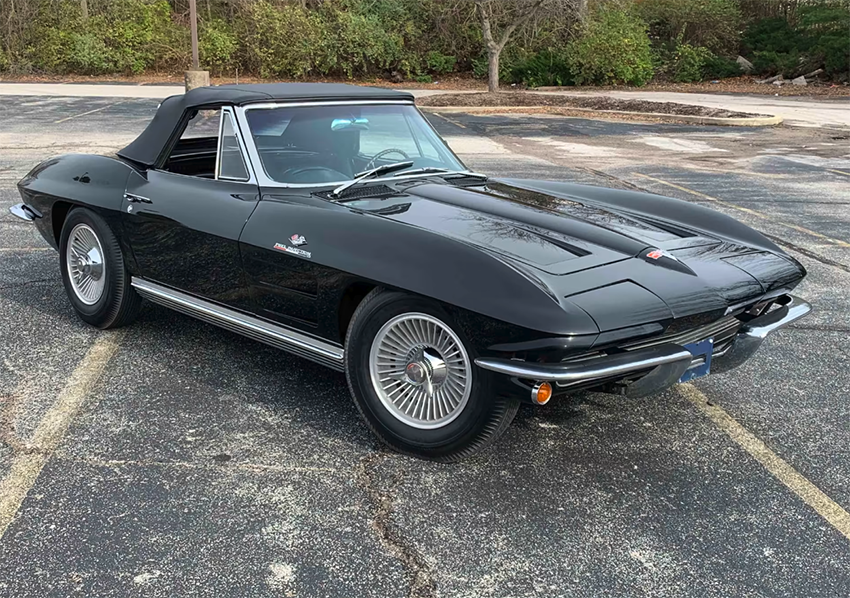
1965 C2 Corvette: Disc Brakes & 396ci V8 Power
Chevrolet made some subtle styling changes to the 1965 Corvette’s exterior. They removed the indentations in the hood and front fender sides and added functional cooling gills (louvers) in the front fenders for removing heat from the engine bay. For the first time, side exhaust pipes were also available as an option.
As far as the mechanicals go, customers could now select a big block V8 Corvette. The 396-cubic inch V8 was rated at 425-horsepower. Four-wheel disc brakes were standard starting in 1965, though customers could still order drum brakes all around as a $64.50 credit option. Just 316 of the 23,562 Corvettes built that year came with drum brakes.

Above and two below: Nassau Blue FF paint code was a newly available hue for the 1965 Corvette. This Vette is powered by a ci V8 that makes 300-horsepower. The engine is mated to a Muncie four-speed manual transmission. The dashboard of the Corvette, with the dual pods — gauges on the driver side and glove box on the right, makes you feel like you’re in a fighter jet when you’re in the cockpit.
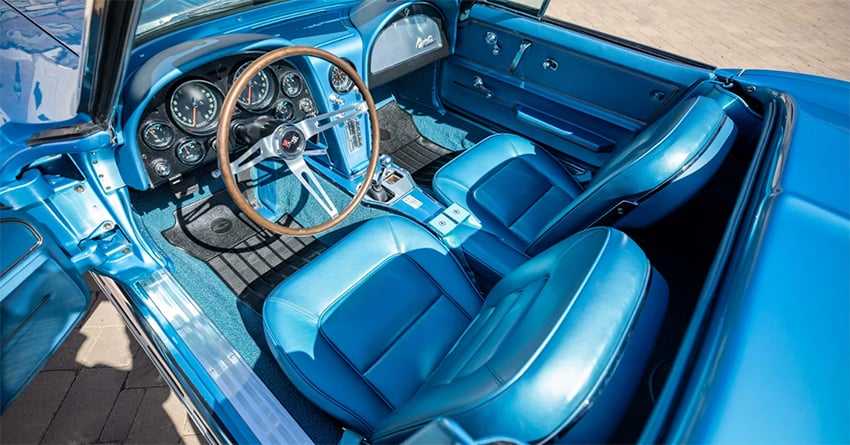
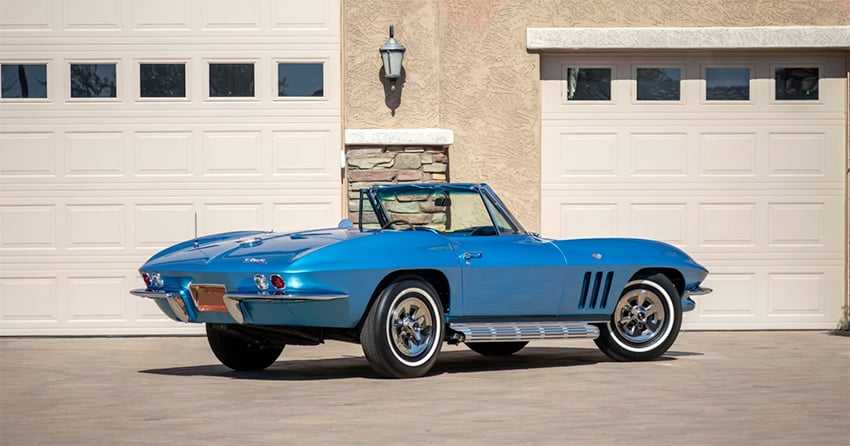
1966 C2 Corvette: Egg Crate Grill & 427ci Big Block
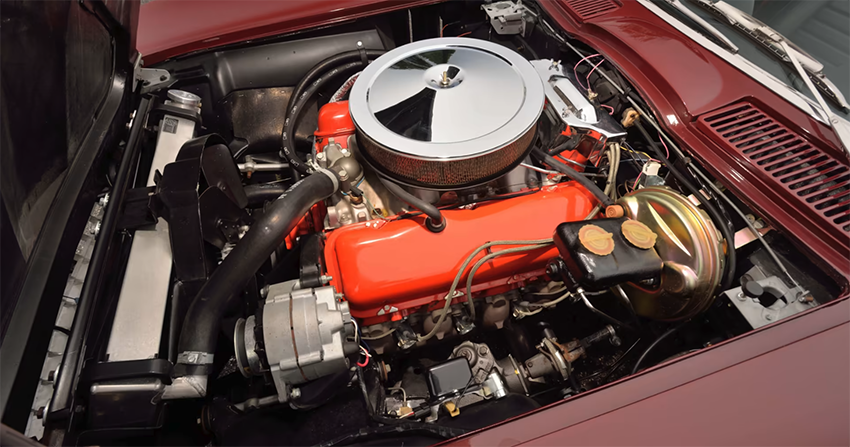
Above and two below: One of the available ci mill’s for the 1966 Corvette is depicted here. This one’s the more powerful 425-horsepower that makes a prodigious 461-pound-foot of torque. To accommodate the 427’s, Chevrolet manufactured a big block power bulge hood. The ’66 also received an egg crate grill, as opposed to the horizontal bar grill of 1965. The Marlboro Maroon exterior is stunning! Not many changes were made to the 1966 model, as Chevrolet originally intended to bring out the third generation (C3) Corvette in 1967. Production delays with the C3 thankfully gave us one more year for the C2 in 1967.

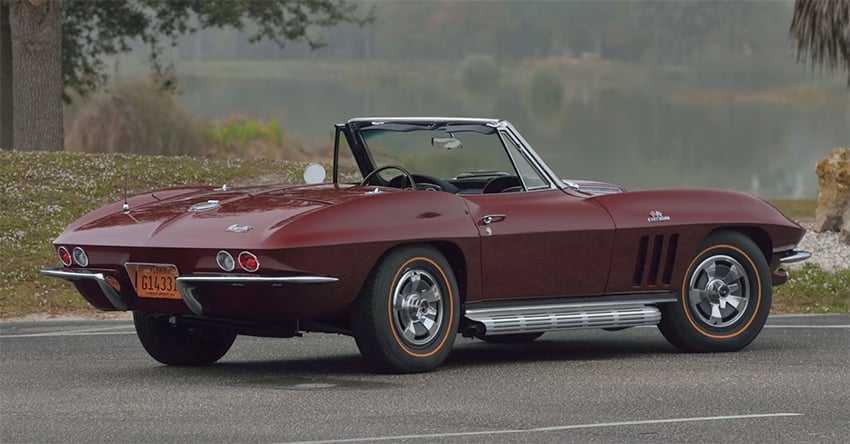
1967 C2 Corvette: Stinger Hood, More Gills, & Optional Hard Top
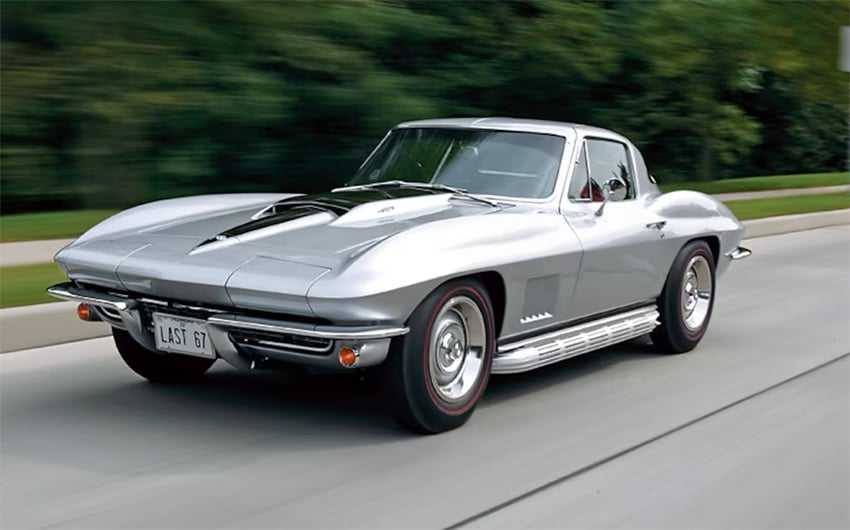
Above and below: Being the most developed C2 Corvette, having the benefit of 10 years of refinement — from concepts, to prototypes, to production — the 1967 C2 Sting Ray is considered the best of the breed. For 1967, the big block powered Vettes received a new fake hood scoop hood that Chevrolet’s marketing department aptly named a Stinger hood to accommodate the larger engine. The Stinger would often be painted the color of the seats, but not always. Another cosmetic change was the smaller five cooling louvers (gills) as opposed to the three large ones for the 1965-66 models. If you purchased a convertible C2, you could pay for an optional removable hard top. The first owner of this gorgeous, unrestored Goodwood Green convertible, purchased the vehicle with the hard top and without the convertible top (ordered as a soft top delete). Without the external side pipes, this 427-powered Corvette is a bit of a sleeper, as it’s equipped with the 3×2 (three, two-barrel carburetor), solid-lifter, 435-horsepower big block V8. (Several photos are courtesy of the GM Heritage Collection and Mecum Auctions).



THE FIRST STING RAY
Unfortunately for Mitchell, Duntov, and the designers, the economic downturn of 1957 and 1958 put a damper on the Q projects. The 1958 model year was awful for Detroit, with sales of most cars down 30% or more — not a good time for a radical new design. GM management first froze and then canceled the Q-sedan project. Zora Arkus-Duntov, knowing which way the wind was blowing, admitted frankly to Chevy chief engineer Harry Barr that the Q-Corvette would be too expensive to justify on its own. It too was canceled.
Also affecting the Corvette’s fortunes was the AMA racing ban. In June 1957, the Automobile Manufacturers Association resolved that its members (which included all the major U.S. automakers) would not participate in, support, or promote racing, or advertise automotive performance in any way. Some division managers honored the ban more in the breach than in the observance, but GM senior management took it very seriously.
The 1963–1967 Corvette Sting Ray was actually slightly smaller than its 1958–1962 predecessors: 175.3 inches (4,453 mm) long on a 98-inch (2,489mm) wheelbase. The Sting Ray’s pop-up headlamps hearken back to the 1957 Q-Corvette study; they were not well liked by critics, but they became a Corvette trademark that lasted until the C6 model of 2005-on. Alloy wheels were an expensive option ($322.80), prized today. This car, incidentally, is a RHD conversion, seen at a show in New South Wales, Australia. (Photo: “1965 Chevrolet Corvette C2 Sting Ray” 2015 Jeremy; used under a Creative Commons Attribution 2.0 Generic license)
When the Q-Corvette was canceled, Mitchell decided he would develop it himself for a race car of his own. In December 1958, he bought the chassis of the Corvette SS — a development mule for the now-defunct Corvette competition program — from GM for a token payment of $1. He then got stylist Chuck Pohlman to convert Pete Brock’s Q-Corvette proposal into a roadster and enlisted stylists Tony Lapine, Gene Garfinkle, and Larry Shinoda to build it in a separate studio nicknamed the “Hammer Room.” Although the designers gave Mitchell’s car a GM project code — XP-96 — Pete Brock later recalled that it was built in secret, to avoid trouble with senior management for flaunting the AMA ban.
The XP-96, which Mitchell dubbed Sting Ray, was finished by early 1959. It made its racing debut in the Sports Car Club of America (SCCA) President’s Cup race in April, driven by dentist Dick Thompson. The Sting Ray eventually won its class (C-Modified) for both 1959 and 1960, although Mitchell privately admitted it cost him a fortune.
Enter the Mark IV Big Block
Just like many credit the Small Block Chevy V8 for saving the C1 Corvette, some folks point to the Mark IV Chevy Big Block engine for giving the C2 Corvette its high-performance swagger. And it’s easy to see why.
 The world got introduced to the Chevy Big Block thanks to the 396ci powerplant of the 1965 Chevy Corvette Sting Ray. (Image/OnAllCylinders)
The world got introduced to the Chevy Big Block thanks to the 396ci powerplant of the 1965 Chevy Corvette Sting Ray. (Image/OnAllCylinders)
Introduced in 1965, the gearhead world first met the Mark IV Chevy Big Block in the Corvette, though the engine would soon find its way into other cars in Chevy’s full size and intermediate fleet, including the Chevelle and Impala. Initially displacing 396 cubic inches with a 4.094 inch bore and 3.760 inch stroke, the engine made 425 horsepower in the Corvette’s L78 spec.
 Thanks to a unique hood bulge, it was easy to tell which 1965-66 Corvettes carried the new Mark IV Big Block. (Image/OnAllCylinders)
Thanks to a unique hood bulge, it was easy to tell which 1965-66 Corvettes carried the new Mark IV Big Block. (Image/OnAllCylinders)
For 1966, the 396 engine grew to 427 cubes, thanks to an increased 4.250 inch bore (the 3.760 inch stroke remained). At launch, the 1966 Corvette’s 427 came in two flavors: RPO L36 which cranked out 390 horsepower, and RPO L72 that was good for 425 horsepower.
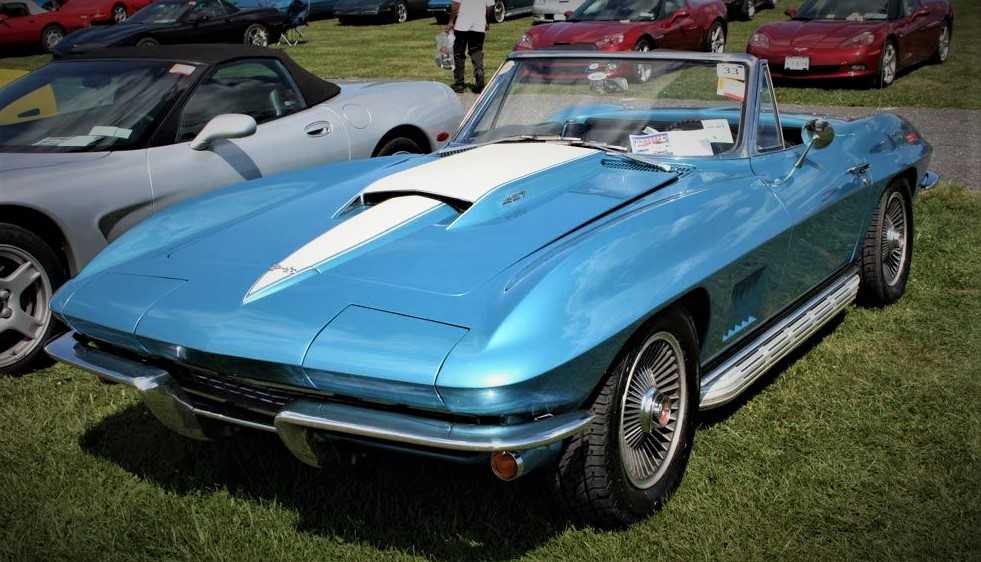 While the 427ci Big Block showed up in 1966, its iconic Big Block “Stinger Hood” seen here wouldn’t arrive until 1967. (Image/OnAllCylinders – Jeff Lee)
While the 427ci Big Block showed up in 1966, its iconic Big Block “Stinger Hood” seen here wouldn’t arrive until 1967. (Image/OnAllCylinders – Jeff Lee)
But Chevy really turned up the Big Block wick in 1967.
While a 435 horsepower L71 appeared to be the top shelf 427 on the options sheet, savvy buyers could also choose a mysterious new L88 which, on paper, “only” made 430 hp. Truth is, those 430 ponies were laughably understated—while GM was mum on an official number, most historians peg L88 horsepower at well over 500.
 There were seven different big blocks available in the C2 Sting Ray—and six of those were 427s. (Image/OnAllCylinders)
There were seven different big blocks available in the C2 Sting Ray—and six of those were 427s. (Image/OnAllCylinders)
That’s because the L88 was essentially a race-spec engine, running an aggressive mechanical cam and tight 12.5:1 compression. As a result, the engine demanded high octane fuel—and even came with warning decals reminding you of such. The engine’s rowdy demeanor meant that it was a low-volume seller, making L88-equipped Corvettes extremely rare and desirable today (we’re talking potentially millions of dollars here).























